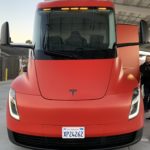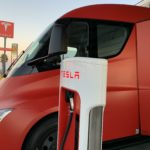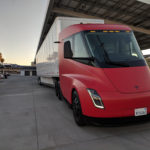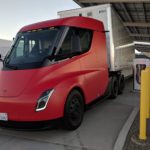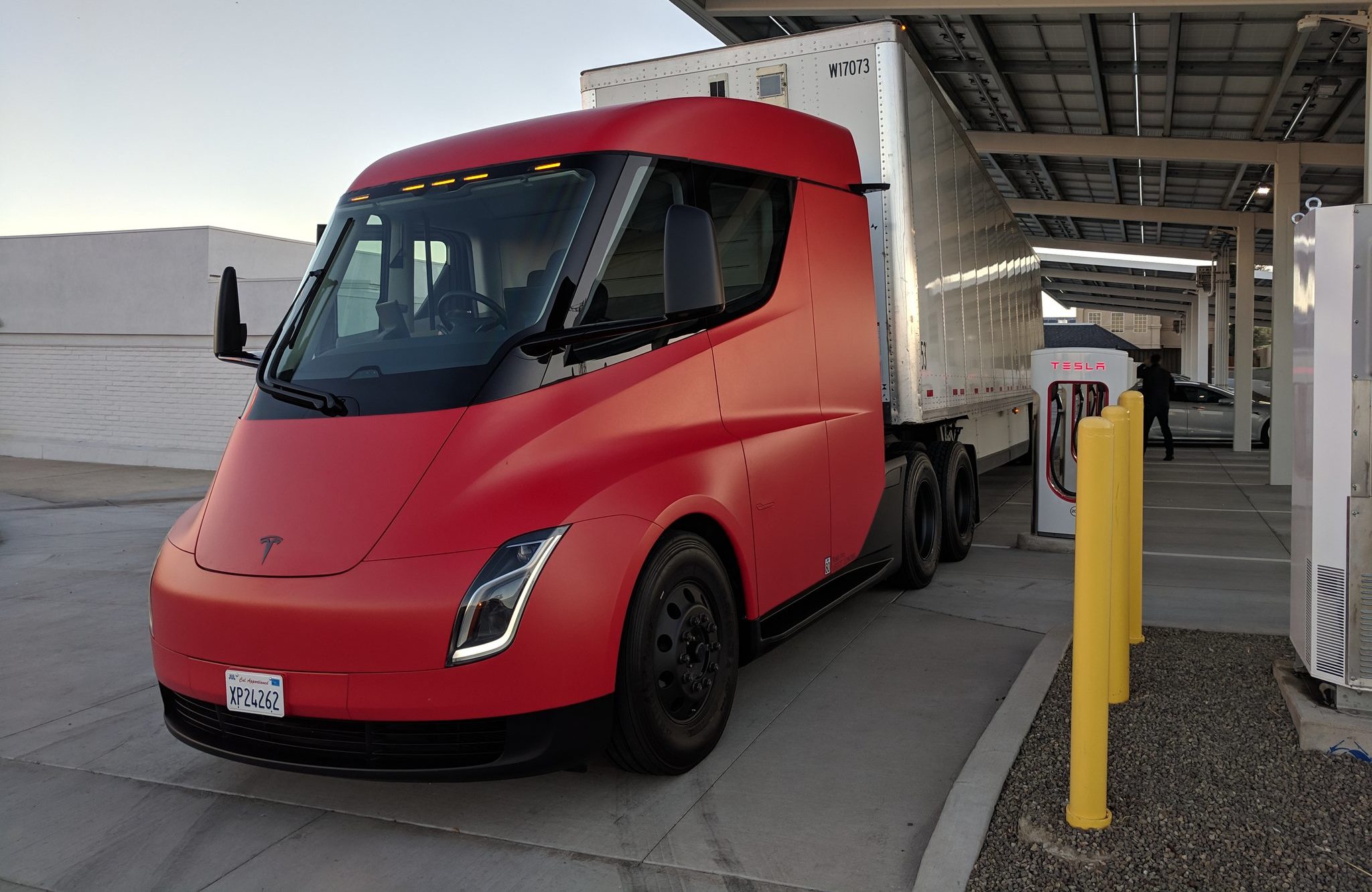
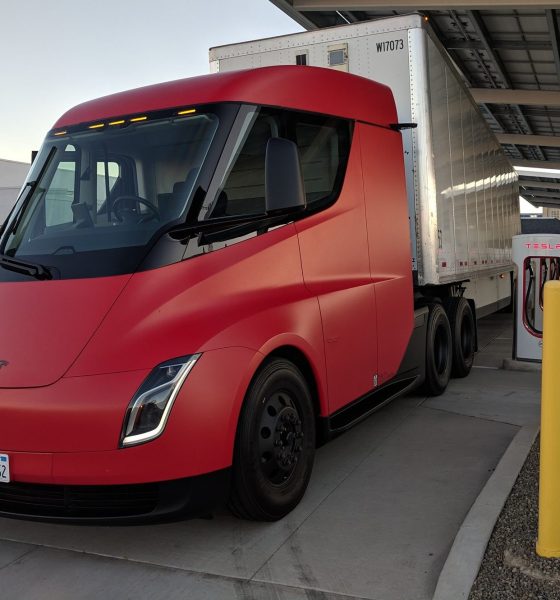
News
Tesla wraps matte black Semi prototype in stunning red amid continued road tests
Tesla has seemingly decided to spice up the road tests of its all-electric truck, wrapping one of its test mules in a stunning matte red color. The vehicle, which has caught the attention of the Tesla community, was spotted on the 405 in LA, before being sighted in the Kettleman City Supercharger.
While Tesla’s silver and matte black Semi prototypes are eye-catching trucks in their own right, there is no doubt that the matte red wrap makes the vehicle downright stunning. Inasmuch as initial sightings of the red test mule suggested that Tesla had produced another prototype, though, details such as the truck’s license plate and its trailer proved that the vehicle was just a wrapped version of the matte black prototype that Elon Musk debuted during the long-hauler’s unveiling.
Unlike prior sightings of the Semi, the matte red test mule appears to have stayed at the Kettleman City Supercharger for a rather long time. Tesla enthusiast and r/TeslaMotors member u/CardSpecialist, who sighted the vehicle in the Supercharger after sundown, noted that he was able to speak briefly with the Semi’s driver. According to the Tesla enthusiast, the driver of the vehicle stated that the red wrap has been getting a lot more looks compared to the truck’s previous matte black paint scheme.
- [Photo: Tim Alguire/Twitter]
- [Photo: Tim Alguire/Twitter]
- [Photo: Derek Rasina/Twitter]
- [Photo: Derek Rasina/Twitter]
The Tesla Semi in matte red. (Photo: Derek Rasina and Tim Alguire/Twitter)
Tesla is yet to provide any details behind its decision to change the color of one of its Semi test mules. That said, the new wrap does make the vehicle stand out more, resulting in more visibility for the upcoming all-electric long-hauler. With such an eye-popping color scheme, after all, the vehicle would likely catch the attention of even more potential reservation holders.
The Tesla Semi might be taking a backseat to the Model 3 for now, but the vehicle has a lot of potential to disrupt a very lucrative industry. To say that the trucking market presents a huge opportunity for Tesla is an understatement, considering that it is responsible for handling the transportation of up to 71% of the United States’ food, retail goods, and other cargo being delivered every day. The American Trucking Associations’ American Trucking Trends 2018 report, for one, noted that the US trucking industry generated $700.3 billion in economic activity last year. This is a market that Tesla could breach if the Semi proves to be a success.
The Tesla Semi definitely appears to have the necessary goods to disrupt the trucking industry. The Semi is a Class 8 truck, allowing it to haul a considerable amount of cargo. Performance-wise, the Semi also stands to shame its diesel counterparts, thanks to its four Model 3-derived electric motors that allow it to accelerate from 0 to 60 mph in 5 seconds flat without a trailer. With a full load, the Semi reaches highway speeds in 20 seconds, considerably faster than its fossil fuel-powered counterparts.
The Tesla Semi is also set to be equipped with semi-autonomous features. Among these is “Convoy Mode,” which would allow multiple trucks to semi-autonomously draft in close proximity with each other. Concept videos of the feature posted by Tesla show one manned Semi leading a couple of unmanned electric trucks. Musk noted during the vehicle’s unveiling that the Semi’s convoy tech is something that Tesla can already accomplish today.
The Tesla Semi is expected to start production sometime in 2019, though later statements from Tesla head of investor relations Martin Viecha suggested that the company would “earnestly” start producing the vehicle by 2020.

Elon Musk
Starlink passes 9 million active customers just weeks after hitting 8 million
The milestone highlights the accelerating growth of Starlink, which has now been adding over 20,000 new users per day.

SpaceX’s Starlink satellite internet service has continued its rapid global expansion, surpassing 9 million active customers just weeks after crossing the 8 million mark.
The milestone highlights the accelerating growth of Starlink, which has now been adding over 20,000 new users per day.
9 million customers
In a post on X, SpaceX stated that Starlink now serves over 9 million active users across 155 countries, territories, and markets. The company reached 8 million customers in early November, meaning it added roughly 1 million subscribers in under seven weeks, or about 21,275 new users on average per day.
“Starlink is connecting more than 9M active customers with high-speed internet across 155 countries, territories, and many other markets,” Starlink wrote in a post on its official X account. SpaceX President Gwynne Shotwell also celebrated the milestone on X. “A huge thank you to all of our customers and congrats to the Starlink team for such an incredible product,” she wrote.
That growth rate reflects both rising demand for broadband in underserved regions and Starlink’s expanding satellite constellation, which now includes more than 9,000 low-Earth-orbit satellites designed to deliver high-speed, low-latency internet worldwide.
Starlink’s momentum
Starlink’s momentum has been building up. SpaceX reported 4.6 million Starlink customers in December 2024, followed by 7 million by August 2025, and 8 million customers in November. Independent data also suggests Starlink usage is rising sharply, with Cloudflare reporting that global web traffic from Starlink users more than doubled in 2025, as noted in an Insider report.
Starlink’s momentum is increasingly tied to SpaceX’s broader financial outlook. Elon Musk has said the satellite network is “by far” the company’s largest revenue driver, and reports suggest SpaceX may be positioning itself for an initial public offering as soon as next year, with valuations estimated as high as $1.5 trillion. Musk has also suggested in the past that Starlink could have its own IPO in the future.
News
NVIDIA Director of Robotics: Tesla FSD v14 is the first AI to pass the “Physical Turing Test”
After testing FSD v14, Fan stated that his experience with FSD felt magical at first, but it soon started to feel like a routine.

NVIDIA Director of Robotics Jim Fan has praised Tesla’s Full Self-Driving (Supervised) v14 as the first AI to pass what he described as a “Physical Turing Test.”
After testing FSD v14, Fan stated that his experience with FSD felt magical at first, but it soon started to feel like a routine. And just like smartphones today, removing it now would “actively hurt.”
Jim Fan’s hands-on FSD v14 impressions
Fan, a leading researcher in embodied AI who is currently solving Physical AI at NVIDIA and spearheading the company’s Project GR00T initiative, noted that he actually was late to the Tesla game. He was, however, one of the first to try out FSD v14.
“I was very late to own a Tesla but among the earliest to try out FSD v14. It’s perhaps the first time I experience an AI that passes the Physical Turing Test: after a long day at work, you press a button, lay back, and couldn’t tell if a neural net or a human drove you home,” Fan wrote in a post on X.
Fan added: “Despite knowing exactly how robot learning works, I still find it magical watching the steering wheel turn by itself. First it feels surreal, next it becomes routine. Then, like the smartphone, taking it away actively hurts. This is how humanity gets rewired and glued to god-like technologies.”
The Physical Turing Test
The original Turing Test was conceived by Alan Turing in 1950, and it was aimed at determining if a machine could exhibit behavior that is equivalent to or indistinguishable from a human. By focusing on text-based conversations, the original Turing Test set a high bar for natural language processing and machine learning.
This test has been passed by today’s large language models. However, the capability to converse in a humanlike manner is a completely different challenge from performing real-world problem-solving or physical interactions. Thus, Fan introduced the Physical Turing Test, which challenges AI systems to demonstrate intelligence through physical actions.
Based on Fan’s comments, Tesla has demonstrated these intelligent physical actions with FSD v14. Elon Musk agreed with the NVIDIA executive, stating in a post on X that with FSD v14, “you can sense the sentience maturing.” Musk also praised Tesla AI, calling it the best “real-world AI” today.
News
Tesla AI team burns the Christmas midnight oil by releasing FSD v14.2.2.1
The update was released just a day after FSD v14.2.2 started rolling out to customers.

Tesla is burning the midnight oil this Christmas, with the Tesla AI team quietly rolling out Full Self-Driving (Supervised) v14.2.2.1 just a day after FSD v14.2.2 started rolling out to customers.
Tesla owner shares insights on FSD v14.2.2.1
Longtime Tesla owner and FSD tester @BLKMDL3 shared some insights following several drives with FSD v14.2.2.1 in rainy Los Angeles conditions with standing water and faded lane lines. He reported zero steering hesitation or stutter, confident lane changes, and maneuvers executed with precision that evoked the performance of Tesla’s driverless Robotaxis in Austin.
Parking performance impressed, with most spots nailed perfectly, including tight, sharp turns, in single attempts without shaky steering. One minor offset happened only due to another vehicle that was parked over the line, which FSD accommodated by a few extra inches. In rain that typically erases road markings, FSD visualized lanes and turn lines better than humans, positioning itself flawlessly when entering new streets as well.
“Took it up a dark, wet, and twisty canyon road up and down the hill tonight and it went very well as to be expected. Stayed centered in the lane, kept speed well and gives a confidence inspiring steering feel where it handles these curvy roads better than the majority of human drivers,” the Tesla owner wrote in a post on X.
Tesla’s FSD v14.2.2 update
Just a day before FSD v14.2.2.1’s release, Tesla rolled out FSD v14.2.2, which was focused on smoother real-world performance, better obstacle awareness, and precise end-of-trip routing. According to the update’s release notes, FSD v14.2.2 upgrades the vision encoder neural network with higher resolution features, enhancing detection of emergency vehicles, road obstacles, and human gestures.
New Arrival Options also allowed users to select preferred drop-off styles, such as Parking Lot, Street, Driveway, Parking Garage, or Curbside, with the navigation pin automatically adjusting to the ideal spot. Other refinements include pulling over for emergency vehicles, real-time vision-based detours for blocked roads, improved gate and debris handling, and Speed Profiles for customized driving styles.
